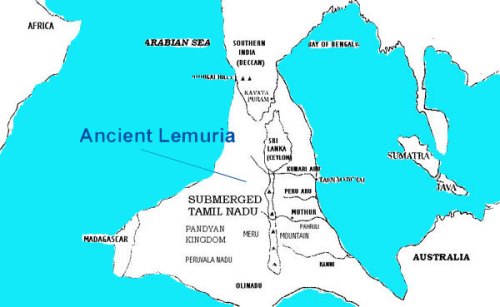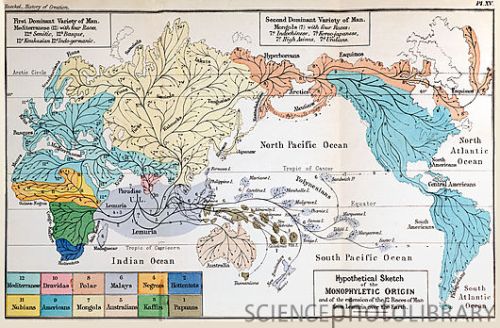Kumari Kandam- The Lost Continent(குமரிக்கண்டம்)
Kumari Kandam- The Lost Continent(குமரிக்கண்டம்)
“Lemuria” in Tamil nationalist mysticist literature, connecting Madagascar, South India and Australia (covering most of the Indian Ocean). Mount Meru stretches southwards from Sri Lanka. The distance from Madagascar to Australia is about 4,200 miles
Kumari Kandam or Lemuria (Tamil:குமரிக்கண்டம்) is the name of a supposed sunken landmass referred to in existing ancient Tamil literature. It is said to have been located in the Indian Ocean, to the south of present-day Kanyakumari district at the southern tip of India.
References in Tamil literature
There are scattered references in Sangam literature, such as Kalittokai 104, to how the sea took the land of the Pandiyan kings, upon which they conquered new lands to replace those they had lost. There are also references to the rivers Pahruli and Kumari, that are said to have flowed in a now-submerged land. The Silappadhikaram, a 5th century epic, states that the “cruel sea” took the Pandiyan land that lay between the rivers Pahruli and the mountainous banks of the Kumari, to replace which the Pandiyan king conquered lands belonging to the Chola and Chera kings (Maturaikkandam, verses 17-22). Adiyarkkunallar, a 12th century commentator on the epic, explains this reference by saying that there was once a land to the south of the present-day Kanyakumari, which stretched for 700 kavatam from the Pahruli river in the north to the Kumari river in the south. As the modern equivalent of a kavatam is unknown, estimates of the size of the lost land vary from 1,400 miles (2,300 km) to 7,000 miles (11,000 km) in length, to others suggesting a total area of 6-7,000 square miles, or smaller still an area of just a few villages.
This land was divided into 49 nadu, or territories, which he names as seven coconut territories (elutenga natu), seven Madurai territories (elumaturai natu), seven old sandy territories (elumunpalai natu), seven new sandy territories (elupinpalai natu), seven mountain territories (elukunra natu), seven eastern coastal territories (elukunakarai natu) and seven dwarf-palm territories (elukurumpanai natu). All these lands, he says, together with the many-mountained land that began with KumariKollam, with forests and habitations, were submerged by the sea.Two of these Nadus or territories were supposedly parts of present-day Kollam and Kanyakumari districts.
None of these texts name the land “Kumari Kandam” or “Kumarinadu”, as is common today. The only similar pre-modern reference is to a “Kumari Kandam” (written குமரிகண்டம், rather than குமரிக்கண்டம் as the land is called in modern Tamil), which is named in the medieval Tamil text Kantapuranam either as being one of the nine continents, or one of the nine divisions of India and the only region not to be inhabited by barbarians. 19th and 20th Tamil revivalist movements, however, came to apply the name to the territories described in Adiyarkkunallar’s commentary to the Silappadhikaram. They also associated this territory with the references in the Tamil Sangams, and said that the fabled cities of southern Madurai and Kapatapuram where the first two Sangams were said to be held were located on Kumari Kandam.
In Tamil national mysticism
In the late 19th and early 20th centuries, Tamil nationalists came to identify Kumari Kandam with Lemuria, a hypothetical “lost continent” posited in the 19th century to account for discontinuities in biogeography. In these accounts, Kumari Kandam became the “cradle of civilization”, the origin of human languages in general and the Tamil language in particular. These ideas gained notability in Tamil academic literature over the first decades of the 20th century, and were popularized by the Tanittamil Iyakkam, notably by self-taught DravidologistDevaneya Pavanar, who held that all languages on earth were merely corrupted Tamil dialects.
R. Mathivanan, then Chief Editor of the Tamil Etymological Dictionary Project of the Government of Tamil Nadu, in 1991 claimed to have deciphered the still undeciphered Indus script as Tamil, following the methodology recommended by his teacher Devaneya Pavanar, presenting the following timeline (cited after Mahadevan 2002):
- ca. 200,000 to 50,000 BC: evolution of “the Tamilian or Homo Dravida“,
- ca. 200,000 to 100,000 BC: beginnings of the Tamil language
- 50,000 BC: Kumari Kandam civilisation
- 20,000 BC: A lost Tamil culture of the Easter Island which had an advanced civilisation
- 16,000 BC: Lemuria submerged
- 6087 BC: Second Tamil Sangam established by a Pandya king
- 3031 BC: A Chera prince in his wanderings in the Solomon Island saw wild sugarcane and started cultivation in Kumari Kandam.
- 1780 BC: The Third Tamil Sangam established by a Pandya king
- 7th century BC: Tolkappiyam (the earliest known extant Tamil grammar)
Mathivanan uses “Aryan Invasion” rhetoric to account for the fall of this civilization:
- “After imbibing the mania of the Aryan culture of destroying the enemy and their habitats, the Dravidians developed a new avenging and destructive war approach. This induced them to ruin the forts and cities of their own brethren out of enmity”.
Mathivanan claims his interpretation of history is validated by the discovery of the “Jaffna seal”, a seal bearing a Tamil-Brahmi inscription assigned by its excavators to the 3rd century BC (but claimed by Mathivanan to date to 1600 BC).
Mathivanan’s theories are not considered mainstream by the contemporary university academy internationally.
Popular culture
Kumari Kandam appeared in the The Secret Saturdays episodes “The King of Kumari Kandam” and “The Atlas Pin.” This version is a city on the back of a giant sea serpent with its inhabitants all fish people.
QUICK FACTS
- Just like Atlantis, the story behind Lemuria and Kumari Kandam is a fascinating one. Kumari Kandam is a lost continent home o the Ancient Tamil people.
- The mythical continent is said to have existed south of modern-day India and is located not below the Indian Ocean.
- Just as with Atlantis, the continent of Kumari Kandam was lost to the sea, and few of its survivors escaped the cataclysmic events and spread across the planet.
- There are several names by which the continents goes depending on spelling it can vary from Kumari Kandam, Kumarikkantam, and Kumari Nadu.
- The word ‘Kumari Kandam’ was first mentioned in a 15th-century version of the Skanda Purana –the largest Mahāpurāṇa, a genre of eighteen Hindu religious texts— and was written by Kachiappa Sivacharyara (1350-1420).
- Contrary to popular belief, the word “Kumari Kandam” derives from the ancient Sanskrit words “Kumarika Khanda.”
- Kumari Kandam is described as the kingdom of the Earth in theAndakosappadalam section of Kanda Puranam.
- Kumari Kandam is considered the cradle of civilization, the place where everything started.
- Many authors indicate that the people of Tamil belong to theoldest civilization on the surface of the planet and when the continent of Kumari Kandam was lost to the sea, its people migrated to other parts of the planet founding different civilizations.
- The continent was mentioned for the first time during the 19th century when scholars proposed the existence of a lost continent called Lemuria, in order to explain strange geological, and biological similarities between India, Africa and the Island of Madagascar.
- After scholars had mentioned the possibility hat three is a lost continent hiding beneath the Indian ocean; people rushed to connect it to ancient legends of lost civilizations mentioned in ancient Tamil and Sanskrit texts.
- It is believed that the ancient people of Tamil called Lemuria their home before a massive catastrophe swallowed the landmass.
- However, modern-day scholars argue such a continent could not have existed, and the theory is rendered obsolete after the continental drift theory.
- Interestingly, there are numerous ancient Tamil and Sanskrit writings that speak of legendary lost lands in South India that have been devoured by the ocean.
- Some authors argue that one of the best pieces of evidence supporting the existence of the lost continent of Kumari Kandam is a 1.7 million-year-old artificial bridge, located in the Palk Strait, in the Indian Ocean called Rama’s Bridge.



Comments
Post a Comment